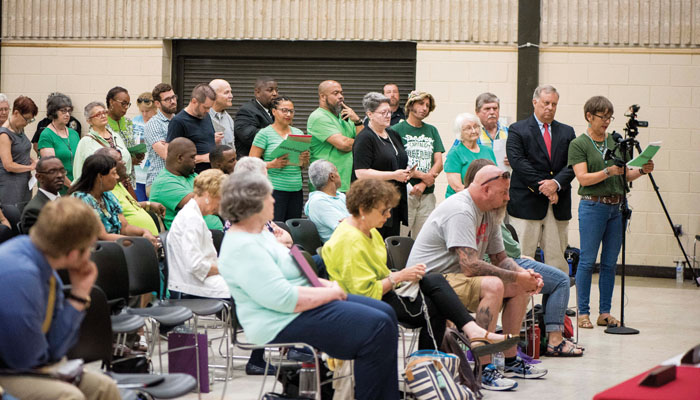Next step in city’s Fame discussion uncertain
Published 12:00 am Friday, June 21, 2019

- A line quickly formed at the microphone, with commenters given three minutes to state their opinion on the future of 'Fame.' Jon C. Lakey/Salisbury Post
SALISBURY — Members of the City Council came to Monday’s meeting on Fame to listen to the public’s thoughts on whether to move or keep the statue at its current location.
So far, they have not discussed the next step.
Council members told the Post they think the legality of Fame being on private property and a state law prevent the city from taking any action.
City Attorney Graham Corriher read a memorandum before the public-comment period Monday to provide his legal opinion that the city is “strictly limited” in relocating the monument. The exception would be if the statue “poses a threat to public safety because of an unsafe or dangerous condition.”
Several residents on Monday said the monument is a public safety issue because of two instances of vandalism and the fact that it is in the median of West Innes Street, which makes it difficult for pedestrians to view it.
Councilman Brian Miller said he interpreted Corriher’s opinion on public safety being whether the statue is in disrepair and could possibly fall on a car. He said council members have taken an oath not to go against the law.
Councilwoman Karen Alexander said, at this point, she is committed to obeying the law of the land.
“I don’t think the statue itself is a public safety issue,” Alexander said. “The people who vandalize it makes it (so). It’s hard for me to say it’s a public safety issue if it’s being vandalized by a group that wants to move it.”
Mayor Pro Tem David Post said if the city chooses to move Fame, it will have a lot of legal hurdles. He also questioned whether the vandalism should be considered a safety problem.
“I’m not sure there is a safety issue, if the two vandalisms count as a safety issue,” Post said.
Councilwoman Tamara Sheffield said the city’s police chief and fire chief are the ones she looks to as experts on whether something is a public safety issue.
Post said he understands both sides. Post said he is puzzled because of the legal problems moving the statue would raise. The United Daughters of the Confederacy own the land, and he believes it’s a slippery slope if the statue is moved.
“I don’t like the idea that we, the government, should do something different, because it offends me,” Post said.
Post said that some people who want it moved initially argued on moral grounds, but now their argument has shifted to public safety.
Both Sheffield and Alexander said those who are for moving the Confederate statue should go to the source of the law — the General Assembly. The legislature passed the Cultural History Artifact Management and Patriotism Act in 2015, limiting the authority to remove or relocate monuments.
“We can’t ignore that law,” Sheffield said. “Those who want to move it should solicit legislators, and those who want to have it remain there should fight for something more concrete, since laws can change.”
“I will follow the law until the law is changed,” Alexander said.
Until then, council members are unsure of their next move. They agreed that hosting the “Fame” meeting Monday was important so they could hear from residents and understand both sides of the conversation.
“I understand why it’s an object of controversy and some see it as evil and offensive,” Miller said.
He and Alexander said the city should continue to recognize African-Americans who have contributed to the Salisbury community. Miller said the city needs to move in a positive direction.
Alexander said residents should appreciate their differences and begin working together on a lot of issues that were mentioned Monday, like poverty, crime and education.
Sheffield said the council should do something, but it needs to be a choice for Salisbury and not any other community.
“I do think inaction is not our friend,” she said. “We need to do what’s right for us. It’s not going to happen tomorrow.”
Post said the council could address the language in the 1908 resolution that gave the land to the United Daughters of the Confederacy to use for “Fame.”
“I think one thing City Council should do is reject the language of the 1908 resolution,” Post said. “Clearly, the statue was put there as a symbol of white supremacy, and that’s wrong.”
The council did not address the Fame meeting at its regular meeting Tuesday. It next meets July 16.
“There has been no discussion of when and how to go forward with the discussion,” Alexander said.
Mayor Al Heggins did not return the Post’s calls for comment before deadline. She said after the Fame meeting that any action would be decided by the whole council.
When asked how the council should proceed, Sheffield replied: “I have that same question. What are the next steps?”



